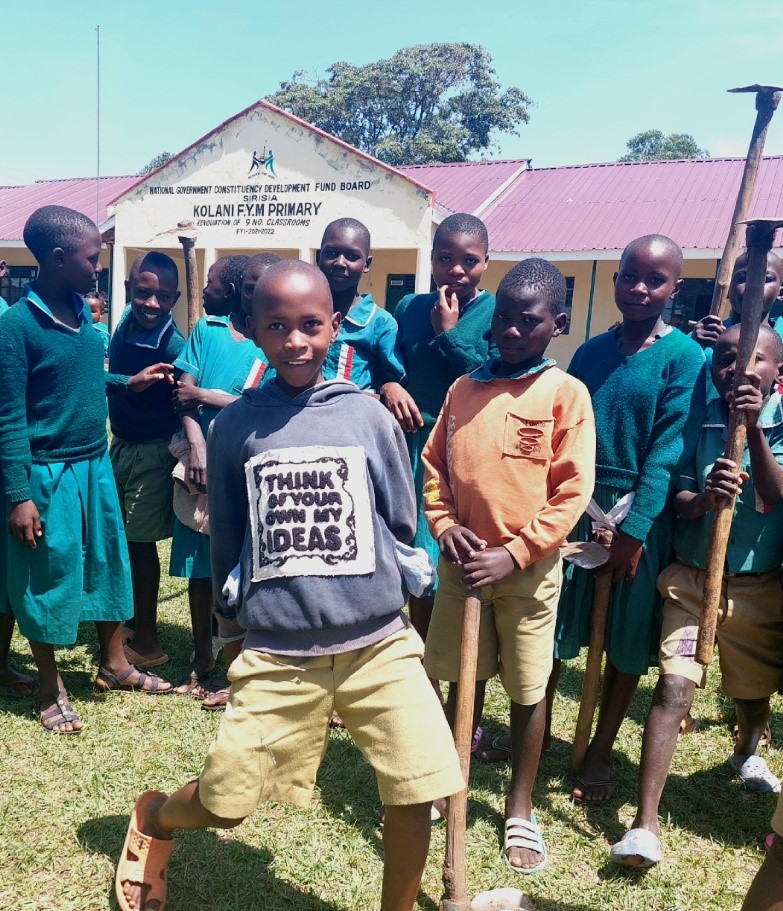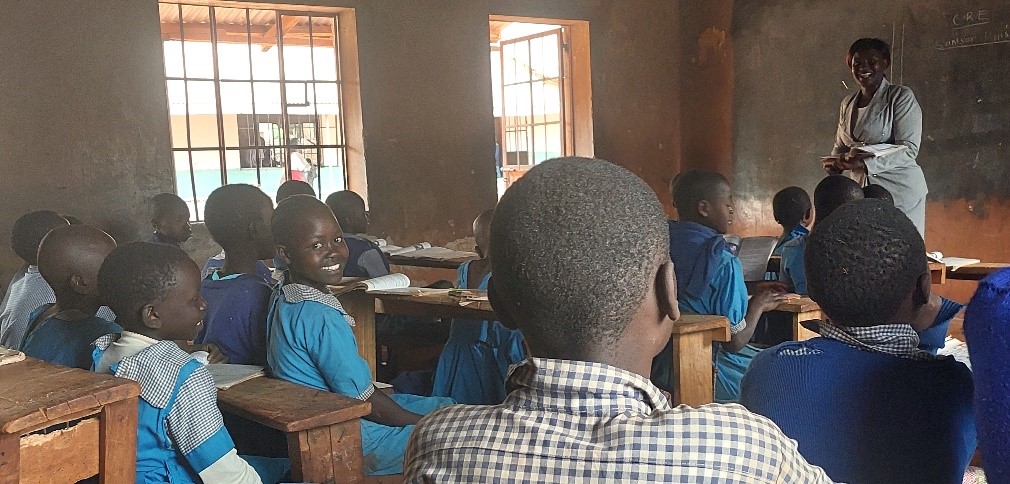Multilingual African Learning Spaces: Translanguaging Practices in Kenyan Schools
-
Research Section: Learning
-
Project duration: 2022 - 2025
Summary
Africa’s linguistic and cultural diversity constitutes both a challenge and a resource for the creation of learning spaces. Recent research has focused on the translanguaging of multilingual speakers who use their full linguistic repertoires, including features from multiple languages to meet communicative and academic needs in their languages (cf. Garcia 2009, Garcia & Li 2014, Hamman 2018). However, the precise processes and motivations to employ translanguaging strategies (e.g., codeswitching, code meshing, use of localised discourse markers and translation) in the classroom as ‘the very heart of the formal educational process’ (Jo Arthur 2013: 374), as well as outside the classroom, and the consequences for learning effects are yet to be empirically investigated. Our focus country, Kenya, has a highly diverse linguistic repertoire using English, Kiswahili, 43 local languages, and Sheng, an urban mixed variety. We want to find out how these languages coexist in formal educational spaces, especially because English is the stipulated language of instruction in Kenya from grade four to higher education. In this research, we explore the extent of communicative competence by learners in rural schools, including their teachers, in the ex-colonial European language of instruction. Thus, this project aims to provide a more detailed understanding of how teachers and learners relationally use translanguaging strategies in multilingual in and out-of-class interactions in Kenyan schools. This study seeks to bridge the gap between the theoretically under-specified relational function of languages and empirical evidence for the effects of multilingual practices in the classroom and within the school premise. The school environment is intriguing to investigate because it offers a learning ecology that shows: (a) the relationship of speakers with other people and texts, (b) the relationship between the languages used in a postcolonial context, as well as (c) an individual’s relationship with the learning environment. We base our discussions on strategic translanguaging and interliteracy in learning processes as well as social interactions, which are interwoven in the relational work approach and the discursive construction of identity, power, and face work in multilingual spaces. The results are expected to blur the dichotomy between the prescribed language of instruction (English) versus the practised language(s) (ethnic Kenyan language(s) and Kiswahili) in both content and language classrooms and outside the classroom. This research is relevant for the ongoing debate on Kenya’s language-in-education policy regarding new possibilities and approaches in multilingual education (cf. Ogutu & Kanana 2003, Mwaniki 2016, Mukewa-Lisanza 2020) which is highly important for communicative competence and dissemination of knowledge. Empirical evidence is crucial here because policies are ‘socially constructed and dynamically negotiated on a moment-by-moment basis’ (Garcia & Menken 2010: 257). While using multiple languages is an excellent resource for Kenyan speakers, it also challenges institutional settings like education, where language choice is highly regulated. In this diverse and multilingual environment, learners face challenges in expressing ideas, negotiating meaning, presenting arguments, and explaining their imaginations, among others, particularly in rural parts of Kenya, where learners are not effectively prepared in language activities to cope with instruction of English language in lower primary schools.
Key Questions
The classroom as an institutional site of learning is in focus here, but we also consider what happens beyond the classroom and within the school environment. The results will reveal both learning practices as well as the social behaviour of multilingual learners and teachers. Here, the dynamics of translanguaging are categorically investigated concentrating on various aspects.
Linguistic practices:
- How do teachers and learners use relational translanguaging strategies in language practice teaching (e.g., Kiswahili or English as a subject) and other content (e.g., mathematics, science) classrooms?
- At which points in(out)side classroom do teachers and learners code-switch, translate or use discourse strategies/markers from a different language?
- What social or linguistic motivation can be seen for the specific translanguaging strategy by teachers? What social or linguistic motivation can we detect in students’ use of the entire linguistic repertoire?
- What role do the ethnic languages (Lubukusu or Nandi) play in(out)side classroom interactions? What role do the hierarchical relationship between the ex-colonial global language English, the regional lingua franca Kiswahili and the local languages play in their use in specific classroom and subject contexts?
Sociolinguistic questions of language use across time and specific groups:
- How, when and why do students and teachers use translanguaging to construct knowledge and build in(out)side classroom identities?
- What role do categories of membership and belonging (gender, religion, among others) play in linguistic choices? How does language use also reflect relationships of status and power?
- How do features of code meshing in second language creative writing of students vary across time?
Implementations of language political decisions:
- What is the relationship between teachers’ and students’ perceptions of translanguaging?
- How can classroom materials be adapted to the translingual competence of students in this multilingual situation?
- To which extent is the integration of translingual approaches in multilingual learning spaces in Kenya successful?
Methods and Concepts
To achieve our objectives, we employ ethnographic research methods: systematic participant observation with audio recordings and transcriptions of learners and their teachers in the classroom and outside the classroom (e.g., teachers among themselves in the staffroom, learners among themselves while playing, and learners with their teachers outside the classroom, but within school premises). We also subject teachers to perceptions and attitude elicitation questionnaires. Additionally, the learners are asked to write essays for which code meshing in their imaginations and codeswitching is investigated.
Vision
We are confident that the research will achieve the following:
- Establish linguistically and socially motivated relational translanguaging strategies in the specific context.
- Provide evidence on how learners use multiple linguistic resources as a way of negotiating meaning, explaining issues, presenting arguments, and justifying their thinking
- Determine and follow (monitor) translanguaging dynamics by grade 4 learners over two years (to grade 6)
- Investigate perceptions on translanguaging by teachers and students vis-à-vis learning potential
- Analyse the multiple values of integrating translingual approaches in teaching and learning
- Develop, monitor, and evaluate the integration of an experimental intervention component for teaching and learning in multilingual classrooms
- Disseminate research output(s) to effect change for a relational approach in Kenya’s syllabus and language-in-education policy
The research will contribute to the fields of applied linguistics, multilingualism, education, and literacy research. The study seeks to add to the existing literature on translanguaging strategies – a relatively recent field – as well as theoretical approaches to multilingualism in the classroom. The empirical contribution (see also method below) will be substantial and provide materials for future research by the international research community. The results are expected to exemplify relational linguistic practices in multilingual African contexts for interaction and learning processes. They are further anticipated to influence the incorporation of a relational approach to the syllabus and teaching materials that take into account the existing observable translanguaging strategies.

An interesting inscription on a sweatshirt innocently worn to school in Kolani village, Bungoma county contributes to the (mis)learning of varieties of English (Photo: Billian Otundo)
Contribution to the Cluster’s Aims & Goals
With the critical issues of relationality and multiplicity, the results are expected to exemplify relational linguistic practices in multilingual African contexts for learning processes, influence the incorporation of a relational approach to the syllabus and teaching materials that allow for translanguaging strategies, and create synergies with similar research issues on relational aspects of communication in learning spaces in the Cluster’s ACCs. The output(s), outcome(s) and recommendations will be disseminated through conference papers, workshop reports, roundtable proceedings, seminar discussions, project and university websites, and publications. Both audio-recorded and text data generated from the research participants and falls within the subtheme of learning within the Cluster will be disseminated through the Digital Research Environment (DRE) to be available to all Cluster members. The multilingual ecology under investigation is rather commonly found in African contexts; therefore, particular aspects of the outcome of this project, while explicitly located in Kenya, might also be transferred to other African settings and beyond.
Recent workshop: Making Meaning, Shaping Knowledge: Practices and Perspectives in African and African Diasporic Multilingual Spaces
The workshop “Making Meaning, Shaping Knowledge: Practices and Perspectives in African and African Diasporic Multilingual Spaces” is grounded in the understanding that speaking and thinking are intimately intertwined.
Project Team

Prof. Dr. Susanne Mühleisen
Professor of English Linguistics
Principal Investigator
University of Bayreuth

Dr. Billian Khalayi Otundo
Postdoctoral Researcher
University of Bayreuth
Further Links / Key References
- García, O. (2009). Bilingual Education in the 21st Century: A Global Perspective. Wiley/Blackwell.
- García, O. & Menken, K. (2010). Stirring the onion: Educators and the dynamics of language education policies (looking ahead). In K. Menken & O. García (Eds.). Negotiating Language Policies in Schools: Educators as Policymakers (pp. 249–261). London and New York: Routledge.
- García, O. & W. Li. (2014). Translanguaging: Language, Bilingualism and Education. Palgrave/Macmillan.
- Hamman, L. (2018). “Translanguaging and positioning in two-way dual language classrooms: a case for critcality.” Language and Education, 32(1), 21–42.
- Mukewa-Lisanza, E. (2020). The Multivoices of Kenyan Primary School Children Learning to Read and Write. Palgrave/Macmillan
- Mwaniki, M. (2016). ”Translanguaging as class/lecture-room language management strategy in multilingual contexts: insights from autoethnographic snapshots from Kenya and South Africa. Southern African Linguistics and Applied Language Studies 34(3): 197–209.
- Ogutu, E. A. & Kanana, F. E. (2003). Code Switching in Multilingual Situations: Opposing Views. Conference Proceedings of ATWS Conference, September 17–19, 2003.




